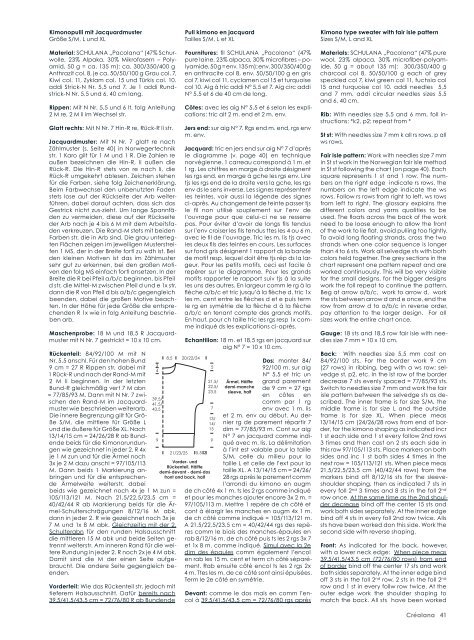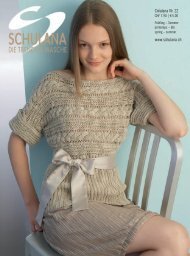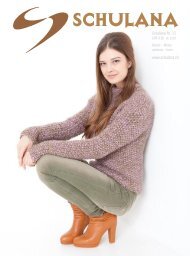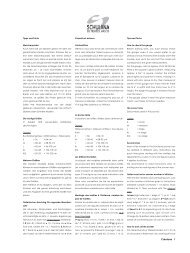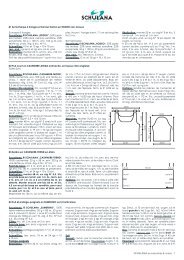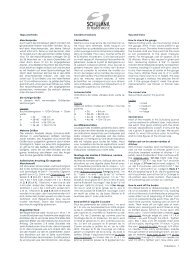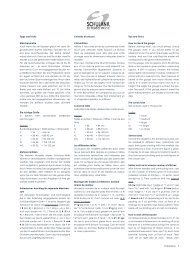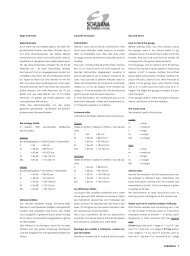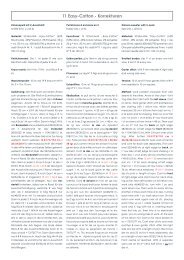Anleitungen Créalana Nr. 27 - Schulana
Anleitungen Créalana Nr. 27 - Schulana
Anleitungen Créalana Nr. 27 - Schulana
- No tags were found...
You also want an ePaper? Increase the reach of your titles
YUMPU automatically turns print PDFs into web optimized ePapers that Google loves.
Kimonopulli mit JacquardmusterGröße S/M, L und XLPull kimono en jacquardTailles S/M, L et XLKimono type sweater with fair isle patternSizes S/M, L and XLMaterial: SCHULANA „Pacolana“ (47% Schurwolle,23% Alpaka, 30% Mikrofasern – Polyamid,50 g = ca. 135 m): ca. 300/350/400 gAnthrazit col. 8, je ca. 50/50/100 g Grau col. 7,Kiwi col. 11, Zyklam col. 15 und Türkis col. 10.addi Strick-N <strong>Nr</strong>. 5,5 und 7. Je 1 addi Rundstrick-N<strong>Nr</strong>. 5,5 und 6, 40 cm lang.Rippen: Mit N <strong>Nr</strong>. 5,5 und 6 lt. folg Anleitung2 M re, 2 M li im Wechsel str.Glatt rechts: Mit N <strong>Nr</strong>. 7 Hin-R re, Rück-R li str.Jacquardmuster: Mit N <strong>Nr</strong>. 7 glatt re nachZählmuster (s. Seite 40) in Norwegertechnikstr. 1 Karo gilt für 1 M und 1 R. Die Zahlen reaußen bezeichnen die Hin-R, li außen dieRück-R. Die Hin-R stets von re nach li, dieRück-R umgekehrt ablesen. Zeichen stehenfür die Farben, siehe folg Zeichenerklärung.Beim Farbwechsel den unbenutzten Fadenstets lose auf der Rückseite der Arb weiterführen,dabei darauf achten, dass sich dasGestrick nicht zus-zieht. Um lange Spannfädenzu vermeiden, diese auf der Rückseiteder Arb nach je 4 bis 6 M mit dem Arbeitsfadenverkreuzen. Die Rand-M stets mit beidenFarben str, die in Arb sind. Die grau unterlegtenFlächen zeigen im jeweiligen Musterstreifen1 MS, der in der Breite fortl zu wdh ist. Beiden kleinen Motiven ist das im Zählmustersehr gut zu erkennen, bei den großen Motivenden folg MS einfach fortl ansetzen. In derBreite die R bei Pfeil a/b/c beginnen, bis Pfeild str, die Mittel-M zwischen Pfeil d und e 1x str,dann die R von Pfeil d bis a/b/c gegengleichbeenden, dabei die großen Motive beachten.In der Höhe für jede Größe die entsprechendenR 1x wie in folg Anleitung beschriebenarb.Maschenprobe: 18 M und 18,5 R Jacquardmustermit N <strong>Nr</strong>. 7 gestrickt = 10 x 10 cm.Rückenteil: 84/92/100 M mit N<strong>Nr</strong>. 5,5 anschl. Für den hohen Bund9 cm = <strong>27</strong> R Rippen str, dabei mit1 Rück-R und nach der Rand-M mit2 M li beginnen. In der letztenBund-R gleichmäßig vert 7 M abn= 77/85/93 M. Dann mit N <strong>Nr</strong>. 7 zwischenden Rand-M im Jacquardmusterwie beschrieben weiterarb.Die innere Begrenzung gilt für GrößeS/M, die mittlere für Größe Lund die äußere für Größe XL. Nach13/14/15 cm = 24/26/28 R ab Bundendebeids für die Kimonorundungenwie gezeichnet in jeder 2. R 4xje 1 M zun und für die Ärmel noch3x je 2 M dazu anschl = 97/105/113M. Dann beids 1 Markierung anbringenund für die entsprechendeÄrmelweite weiterstr, dabeibeids wie gezeichnet noch 4x je 1 M zun =105/113/121 M. Nach 21,5/22,5/23,5 cm =40/42/44 R ab Markierung beids für die Ärmel-Schulterschrägungen8/12/16 M abk,dann in jeder 2. R wie gezeichnet noch 3x je7 M und 1x 8 M abk. Gleichzeitig mit der 2.Schulterabn für den runden Halsausschnittdie mittleren 15 M abk und beide Seiten getrenntweiterstr. Am inneren Rand für die weitereRundung in jeder 2. R noch 2x je 4 M abk.Damit sind die M der einen Seite aufgebraucht.Die andere Seite gegengleich beenden.Vorderteil: Wie das Rückenteil str, jedoch mittieferem Halsausschnitt. Dafür bereits nach39,5/41,5/43,5 cm = 72/76/80 R ab Bundende3439,5/41,5/43,59Fournitures: fil SCHULANA „Pacolana“ (47%pure laine, 23% alpaca, 30% microfibres – polyamide,50 g = env. 135 m): env. 300/350/400 gen anthracite col 8, env. 50/50/100 g en griscol 7, kiwi col 11, cyclamen col 15 et turquoisecol 10. Aig à tric addi N° 5,5 et 7. Aig circ addiN° 5,5 et 6 de 40 cm de long.Côtes: avec les aig N° 5,5 et 6 selon les explications:tric alt 2 m. end et 2 m. env.Jers end: sur aig N° 7. Rgs end m. end, rgs envm. env.Jacquard: tric en jers end sur aig N° 7 d’aprèsle diagramme (v. page 40) en techniquenorvégienne. 1 carreau correspond à 1 m. et1 rg. Les chiffres en marge à droite désignentles rgs end, en marge à gche les rgs env. Liretjs les rgs end de la droite vers la gche, les rgsenv ds le sens inverse. Les signes représententles teintes, voir aussi la légende des signesci-après. Au changement de teinte passer tjsle fil non utilisé souplement sur l’env del’ouvrage pour que celui-ci ne se resserrepas. Pour éviter d’avoir de longs fils tendussur l’env croiser les fils tendus ttes les 4 ou 6 m.avec le fil de l’ouvrage. Tric les m. lis tjs avecles deux fils des teintes en cours. Les surfacessur fond gris désignent 1 rapport ds la bandede motif resp, lequel doit être tjs rép ds la largeur.Pour les petits motifs, ceci est facile àrepérer sur le diagramme. Pour les grandsmotifs rapporter le rapport suiv tjs à la suiteles uns des autres. En largeur comm le rg à laflèche a/b/c et tric jusqu’à la flèche d, tric 1xles m. cent entre les flèches d et e puis termle rg en symétrie de la flèche d à la flèchea/b/c en tenant compte des grands motifs.En haut, pour ch taille tric les rgs resp 1x commeindiqué ds les explications ci-après.8,5 20/22/24Echantillon: 18 m. et 18,5 rgs en jacquard suraig N° 7 = 10 x 10 cm.21/23/25 5,5 2Vorder- undRückenteil, Hälftedemi-devant - demi-dosfront and back, half521,5/22,5/23,5713/14/159Ärmel, Hälftedemi-manchesleeve, halfDos: monter 84/92/100 m. sur aigN° 5,5 et tric ungrand parementde 9 cm = <strong>27</strong> rgsen côtes encomm par 1 rgenv avec 1 m. liset 2 m. env au début. Au dernierrg de parement répartir 7dim = 77/85/93 m. Cont sur aigN° 7 en jacquard comme indiquéavec m. lis. La délimitationà l’int est valable pour la tailleS/M, celle du milieu pour lataille L et celle de l’ext pour lataille XL. A 13/14/15 cm = 24/26/28 rgs après le parement comml’arrondi du kimono en augmde ch côté 4x 1 m. ts les 2 rgs comme indiquéet pour les manches ajouter encore 3x 2 m. =97/105/113 m. Mettre 1 repère de ch côté etcont à élargir les manches en augm 4x 1 m.de ch côté comme indiqué = 105/113/121 m.A 21,5/22,5/23,5 cm = 40/42/44 rgs des repèrescomm le biais des manches-épaules enrab 8/12/16 m. de ch côté puis ts les 2 rgs 3x 7et 1x 8 m. comme indiqué. Simul avec la 2edim des épaules comm également l’encolen rab les 15 m. cent et term ch côté séparément.Rab ensuite côté encol ts les 2 rgs 2x4 m. Ttes les m. de ce côté sont ainsi épuisées.Term le 2e côté en symétrie.Devant: comme le dos mais en comm l’encolà 39,5/41,5/43,5 cm = 72/76/80 rgs aprèsMaterials: SCHULANA „Pacolana“ (47% purewool, 23% alpaca, 30% microfiber-polyamide,50 g = about 135 m): 300/350/400 gcharcoal col 8, 50/50/100 g each of greyspeckled col 7, kiwi green col 11, fuchsia col15 and turquoise col 10. addi needles 5,5and 7 mm. addi circular needles sizes 5,5and 6, 40 cm.Rib: With needles size 5,5 and 6 mm, foll instructions:*k2, p2; repeat from *St st: With needles size 7 mm k all rs rows, p allws rows.Fair Isle pattern: Work with needles size 7 mmin St st work in the Norwegian fair isle methodin St st following the chart (on page 40). Eachsquare represents 1 st and 1 row. The numberson the right edge indicate rs rows, thenumbers on the left edge indicate the wsrows. Follow rs rows from right to left, ws rowsfrom left to right. The glossary explains thedifferent colors and yarns qualities to beused. The floats across the back of the workneed to be loose enough to allow the frontof the work to lie flat, avoid pulling too tightly.To avoid long floating strands, cross the twostrands when one color sequence is longerthan 4 to 6 sts. Work all selvedge sts with bothcolors held together. The grey sections in thechart represent one pattern repeat and areworked continuously. This will be very visiblefor the small designs, for the bigger designswork the foll repeat to continue the pattern.Beg at arrow a/b/c, work to arrow d, workthe sts between arrow d and e once, end therow from arrow d to a/b/c in reverse order,pay attention to the larger design. For allsizes work the entire chart once.Gauge: 18 sts and 18,5 row fair isle with needlessize 7 mm = 10 x 10 cm.Back: With needles size 5,5 mm cast on84/92/100 sts. For the border work 9 cm(<strong>27</strong> rows) in ribbing, beg with a ws row: selvedgest, p2, etc. In the lst row of the borderdecrease 7 sts evenly spaced = 77/85/93 sts.Switch to needles size 7 mm and work the fairisle pattern between the selvedge sts as described.The inner frame is for size S/M, themiddle frame is for size L and the outsideframe is for size XL. When piece meas13/14/15 cm (24/26/28 rows from end of border,for the kimono shaping as indicated incr1 st each side and 1 st every follow 2nd rows3 times and then cast on 2 sts each side inthis row 97/105/113 sts. Place markers on bothsides and inc 1 st both sides 4 times in thenext row = 105/113/121 sts. When piece meas21,5/22,5/23,5 cm (40/42/44 rows) from themarkers bind off 8/12/16 sts for the sleeveshouldershaping, then as indicated 7 sts inevery foll 2 nd 3 times and 8 sts in the foll 2 ndrow once. At the same time as the 2nd shoulderdecrease bind off the center 15 sts andwork both sides separately. At the inner edgebind off 4 sts in every foll 2nd row twice. Allssts have been worked don this side. Work thesecond side with reverse shaping.Front: As indicated for the back, however,with a lower neck edge: When piece meas39,5/41,5/43,5 cm (72/76/80 rows) from endof border bind off the center 17 sts and workboth sides separately. At the inner edge bindoff 3 sts in the foll 2 nd row, 2 sts in the foll 2 ndrow and 1 st in every follw row twice. At theouter edge work the shoulder shaping tomatch the back. All sts have been workedCréalana 41


